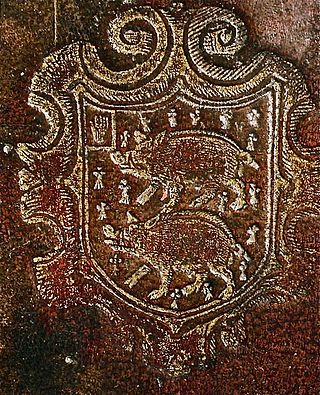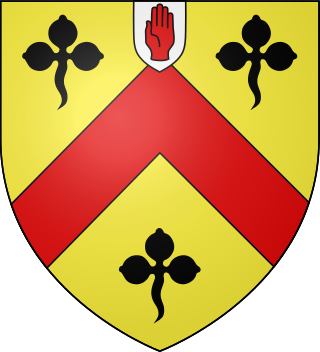The Mellor Baronetcy, of Culmhead in the County of Somerset, was a title in the Baronetage of the United Kingdom. It was created on 24 January 1924 for Sir John Mellor, Director of Prudential Assurance Company. The second Baronet was the Conservative member of parliament for Tamworth from 1935 to 1945 and for Sutton Coldfield from 1945 to 1955. The baronetcy became extinct on the death of the third Baronet in 1990.

The Bunbury Baronetcy, of Bunbury, Oxon and Stanney Hall in the County of Chester, is a title in the Baronetage of England. It was created on 29 June 1681 for Thomas Bunbury, Sheriff of Cheshire from 1673 to 1674 and the member of an ancient Cheshire family. His grandson, Henry, the third Baronet, and great-grandson, the fourth Baronet, both sat as Members of Parliament for Chester. The latter died unmarried at an early age and was succeeded by his younger brother, the fifth Baronet. He was a clergyman. On his death in 1764 the title passed to his eldest son, the sixth Baronet. He represented Suffolk in the House of Commons for over forty years but is best remembered for his marriage to Lady Sarah Lennox. He died childless in 1821 and was succeeded by his nephew, the seventh Baronet. He was the son of Henry Bunbury, younger son of the fifth Baronet. The seventh Baronet was a distinguished soldier and politician. His eldest son, the eighth Baronet, was High Sheriff of Suffolk in 1868, and Fellow of the Royal Society. He died childless in 1886 and was succeeded by his younger brother, the ninth Baronet. He was Liberal Member of Parliament for Bury St Edmunds. He died unmarried in 1895 and was succeeded by his nephew, the tenth Baronet. He was the son of Colonel Henry William St Pierre Bunbury, third son of the seventh Baronet. He served as High Sheriff of Suffolk in 1908 and was a Deputy Lieutenant of the county. On his death in 1930 the title passed to his son, the eleventh Baronet. He was High Sheriff of Suffolk in 1936 and was a Deputy Lieutenant of the county. His son, the twelfth Baronet, was High Sheriff of Suffolk in 1972. As of 2014 the title was held by the latter's second but eldest surviving son, the thirteenth Baronet, who succeeded in 1985.
This is a list of High Sheriffs of Lincolnshire.
Sir John Barrington, 3rd Baronet of Barrington Hall, Essex was an English lawyer and politician who sat in the House of Commons at various times between 1645 and 1679.

There have been twenty one baronetcies created for persons with the surname Williams, eight in the Baronetage of England, three in the Baronetage of Great Britain and ten in the Baronetage of the United Kingdom. Only six of the creations are extant as of 2017.
The Langham Baronetcy, of Cottesbrooke in the County of Northampton, is a title in the Baronetage of England. It was created on 7 June 1660 for John Langham, Member of Parliament for the City of London in 1654 and for Southwark in 1660 and 1661. The second Baronet was Member of Parliament for Northamptonshire and Northampton while the third Baronet sat for Northampton. The seventh Baronet was Member of Parliament for Northamptonshire. The tenth Baronet represented St Germans in the House of Commons. The thirteenth Baronet was a photographer, ornithologist and entomologist and served as High Sheriff of County Fermanagh in 1930.

There have been two baronetcies created for the Guise family, one in the Baronetage of England and one in the Baronetage of Great Britain. The latter creation is extant as of 2014.
Sir John Townshend MP, of Raynham Hall in Norfolk, was an English nobleman, politician, and knight. He was the son of Sir Roger Townshend and Jane Stanhope. He was also a soldier and Member of Parliament. He was killed in a duel with Sir Matthew Browne in August 1603.

Sir Heneage Finch was an English nobleman, lawyer, Member of Parliament, and politician who sat in the House of Commons at various times between 1607 and 1626. He was Speaker of the English House of Commons in 1626.

The Hampson Baronetcy, of Taplow in the County of Buckingham, was a title in the Baronetage of England. It was created by King Charles I on 3 June 1642 for Thomas Hampson, second son of Sir Robert Hampson (1537-1607) one of the two Sheriffs of the City of London in 1599, knighted by King James I in 1603. The third Baronet sat as Member of Parliament for Chipping Wycombe in 1685. The tenth Baronet was an entomologist. The title became extinct on the death of the twelfth Baronet in 1969.

John Smyth was a British politician who sat in the House of Commons from 1783 to 1807.
Sir John Thorold, 4th Baronet of Marston Hall and Cranwell, Lincolnshire was an English politician. He was a Member of Parliament representing either Grantham or Lincolnshire in a number of parliaments between 1697 and 1715.

Sir Francis Whichcote, 3rd Baronet (c.1692-1775), of Quy Hall, Cambridgeshire and Aswarby, Lincolnshire, was an English politician who sat in the House of Commons from 1718 to 1722.
Whichcote is a surname, and may refer to:

Sir Paul Whichcote, 2nd Baronet (1643–1721), was a fellow of the Royal Society and the owner of the Manor of Totteridge in Hertfordshire.

The Palmer Baronetcy, of Carlton in the County of Northampton, was created in the Baronetage of England on 7 June 1660 for the lawyer and politician Geoffrey Palmer. The second Baronet was Member of Parliament for Higham Ferrers. The third, fourth and fifth Baronets all represented Leicestershire in the House of Commons. The fifth Baronet served as High Sheriff of Leicestershire in 1782 and the eighth Baronet as High Sheriff of Northamptonshire in 1871.

The Abdy baronetcy, of Felix Hall, in the County of Essex, was created in the Baronetage of England on 14 July 1641 for Thomas Abdy who was High Sheriff of Essex. The title became extinct in 1868.

The Stapleton Baronetcy, of the Leeward Islands, is an extinct title in the Baronetage of England. It was created on 20 December 1679 for William Stapleton, who followed Charles II into exile in France, and after the Restoration was appointed deputy-governor of Montserrat and captain-general of the Leeward Islands.

The Jackson baronetcy, of The Manor House in Birkenhead, was created in the Baronetage of the United Kingdom on 4 November 1869 for William Jackson, Liberal Member of Parliament for Newcastle under Lyne and Derbyshire North. The 2nd Baronet briefly represented Coventry in Parliament.












